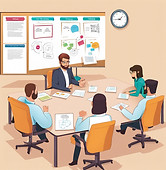Get better at what you do
Improve your workflow efficiency through Kanban
Corporate training for Kanban and Agile practices.

Get quality training tailored to the needs of your organization.

The general principles and practices will be illustrated using customer-provided use cases.
.jpg)
Our certified instructors are industry professionals with years of real-world experience.
%20(2).jpg)
Our courses are both engaging and practical.

Stand out as a certified Kanban expert, Agile practitioner or Product Owner.

Why Kanban?
Kanban is an Agile methodology used to manage and optimize workflow.
Similar to how a system of dams regulates the flow of water in a river, Kanban helps regulate and enhance the flow of value to customers.
It can be applied in both project management and operational work and is based on LEAN management principles.
Do you want to minimize waste, maximize value and create predictability?
Look at the Kanban way of working!
Kanban Canada brings the work experience to the training room.
We explain the principles and we demonstrate the practices.
We tailor the training delivery to exactly what your organization needs.
100% Canadian!
Kanban will help you continuously improve your workflow efficiency.
We tell you why and show you how!
Why KanbanCanada?
Use Case: Managing a funnel of on-demand work requests.

The Reporting team produces a variety of custom financial reports on demand for different departments.
The Reporting team always has a variety of report requests at different stages, with some awaiting processing and others currently in progress.
The Reporting team needs to manage and optimize its workflow to create predictability around expected completion dates and to maximize the value generated throughout the process.
The Reporting team needs a Kanban system.
Use case: Managing a funnel of repetitive work items.

The Service Assurance team handles and resolves customer tickets and cases.
At any given time, the Service Assurance team has several open tickets, with some awaiting processing and others actively being worked on.
The Service Assurance team needs to manage and optimize its workflow to minimize ticket resolution time and maximize the number of tickets closed each day.
The Service Assurance team needs a Kanban system.
Use case: Managing a project backlog.

The Project Delivery team works to complete items from the product backlog.
Because of the diverse nature of items in the product backlog, the Scrum method has proven inefficient in similar past projects.
The Project Delivery team needs to manage and optimize its workflow to reduce delivery times, enhance team efficiency, and maximize the value created.
The Project Delivery team needs a Kanban system.
Our Customers and Partners












About Kanban
The Kanban Method is a means to design, manage, and improve flow systems for knowledge work.
-
Start with what you do now
-
Agree to pursue improvement through evolutionary change
-
Encourage acts of leadership at every level
-
Visualize, Limit work in progress, Manage flow, Make policies explicit, Implement feedback loops, Improve collaboratively, Evolve experimentally
Transparency, Balance, Collaboration, Customer Focus, Flow, Understanding, Agreement, Respect
-
Understand and focus on your customers’ needs
-
Manage the work; let people self-organize around it
-
Evolve policies to improve customer and business outcomes
-
Service Request Manager
-
Service Delivery Manager

